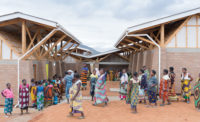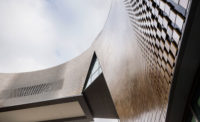Kigutu, Burundi
In a construction photo, dozens of men in bright yellow hard hats dig foundations in coffee-brown soil. Humpbacked mountain ridges disappear in the equatorial mist. In the remote village of Kigutu, in the densely populated but rural east central-African nation of Burundi, you see no backhoes, pickup trucks, or power tools. Just picks, shovels, and wheelbarrows. That suggests the many challenges New York architect Louise Braverman had to understand in designing a deceptively simple 6,000-square-foot dormitory for health-care workers in one of the most impoverished places on earth.
The villagers built a health clinic and a four-mile access road by hand before Braverman got the strangest cold call of her career from then-director of the nonprofit Sarah Broom. “Broom knew about my Chelsea Court housing in New York for homeless and low-income tenants,” Braverman says. “After we discussed designing a women's health pavilion for awhile, she said, 'I'm leaving for Burundi in eight days. Can you come?' ”
“The dignified environment at Chelsea Court was really important to me and to Deo,” Broom says. “The premise is that health is beyond the medical and the physiological. It has to do with the environment: what you see and how you feel.”
Enchanted by the majesty of such a tragic country, Braverman developed a master plan for the whole site that located clinical and housing facilities on terraces that open to long verdant vistas as they step up toward the top of the village's mountain, “where it's coolest,” says Braverman. In the end, the women's pavilion—essentially a small hospital—had to be put off until more money could be raised, a process that continues. In the meantime, Village Health Works went ahead with the 18-bed housing to give heavily burdened medical staff a place of retreat.
To tame the equatorial heat without air-conditioning, Braverman set the structure into the hillside to harvest a cooling effect from the earth. Breezeways between pairs of dormitory rooms encourage natural ventilation, while three exposures, and low windows matched with high windows, helped induce a stack effect to draw more air through the bedrooms. Overhangs further cut heat gain; they also form porches where, Braverman says, “all the life happens.”
As simple as the dormitory looks, Braverman calls it “the ultimate design problem: How do you do the most with the least?” The project, located completely off the energy grid in a community with no modern machinery, was further constricted by policies requiring all imports to come through Dubai, making foreign materials especially costly and placing extra emphasis on local materials and labor. “We needed to create transferable job skills,” she says. “It's a seismic zone that requires 21st-century expertise.”
Instead of conventional construction documents, she supplied three-dimensional diagrams drawn from computer models showing how the building was to be assembled. Working with a Burundian architect, who had designed the previous structures, and a local engineer, she contrived a concrete framing system in spans small enough to be erected by hand, but seismically upgraded by Liam O'Hanlon Engineering. Through almost daily Skype calls, Braverman and the villagers worked out complications she had never imagined. Where do you find a concrete-testing firm? How do you figure out what's wrong when the samples fail?
Bricks made locally wrap the concrete framing. Because the country has largely been denuded of forests, the corrugated- metal roof is supported by metal tubes. Windows had to be imported, but the large steel-framed Eucalyptus sliding doors that open to the shared dining, cooking, and living areas were made locally. An existing PV array nearby supplies electricity only for lighting. Solar thermal tube arrays heat water.
Was it wise to hire an architect so unfamiliar with Burundi? “The people who built our earlier buildings knew some things Louise didn't know,” says Broom. “But she knows about materials and how to build a foundation that won't fall apart. There was a back-and-forth that helped people here learn building techniques they can use in their own lives.”
Working for a reduced fee, Braverman says she thought of herself less as a designer and more “as a resource to collaborate with local people.” Her goal, she says, was to create “architecture of conscience.”
The Agile City: Building Well-being and Wealth in an Era of Climate Change.
People
Owner:
Architect:
Personnel in architect's firm who should receive special credit:
Design Team:
Engineers:
Consultant(s):
Construction Management:
Photographer(s): Size: 6,000 square feet Completion date: October 2013 |
Products
Windows
Doors
Furnishings
Tables:
Other furniture:
Energy |










Post a comment to this article
Report Abusive Comment